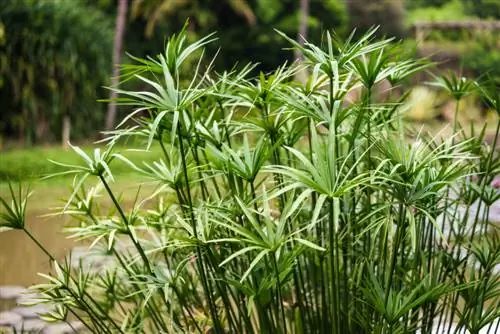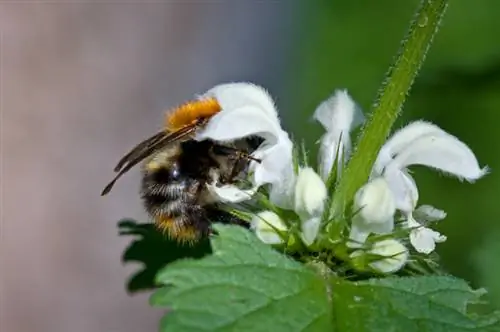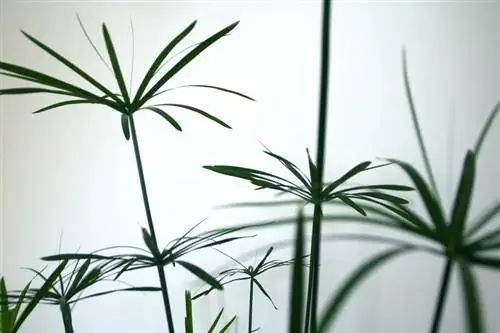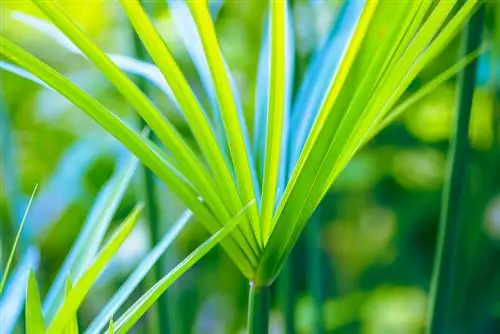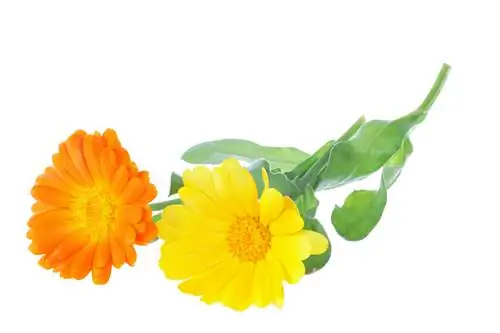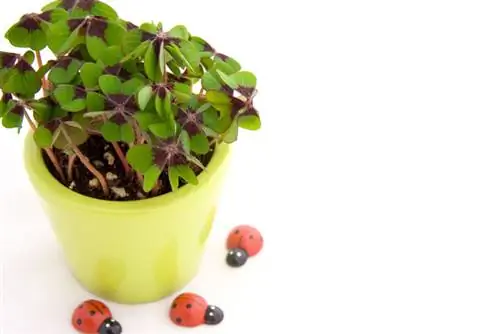- Author admin [email protected].
- Public 2024-01-05 20:48.
- Last modified 2025-06-01 06:02.
Cyprus grasses, with their palm-like fronds, are a very decorative addition to rooms and patios. We have put together for you what makes the swamp plant special and the various ways in which you can cultivate it.

What should you know about caring for Cyprus grass?
Cyprus grass (Cyperus) is a genus of sour grass with over 600 species. As a decorative house and patio plant, Cyprus grass prefers a sunny, warm location and high moisture content. Cyprus grasses are not hardy and should be brought indoors during the winter. They can be propagated by division, seeds or cuttings.
Origin
The plant genus Cyper grasses, botanically Cyperus, is one of the sour grasses and has a very wide range of distribution. They are native to temperate to subtropical and tropical areas of virtually all parts of the world. This diversity of climatic habitats can of course also be attributed to the relatively high species spectrum of around 600 variants. Most species come from North America, followed by Far and Middle Eastern, African and Central American species. Some are also native to us in Europe. In gardening, Cyprus grasses are preferably kept in pots.
Growth
Cyprus grasses mostly grow as perennials from rhizome or tuberous roots, which usually form quite intensive clumps. Some species are only one to two years old. Cyprus grasses form long leaf umbrellas on fine, coagulated stalks, which have given the plant the nickname water palm. The different species grow between 30 and 100 cm high.
leaves
The grass-like, long individual leaves of the leaf umbrellas of Cyprus grass are very narrow and lanceolate with a pointed end. They have entire edges and are green.
Bloom
Cyprus grasses are definitely an ornamental foliage plant from a horticultural perspective (€179.00 on Amazon). The flowers are rather inconspicuous. They appear all year round as small, yellow, tufted spikes above leaf-like bracts.
Which location is suitable?
Cyprus grasses prefer a sunny, bright location. The ambient temperature should be rather warm - they feel very comfortable at room temperature. In summer you can also put your Cyprus grass out and create an exotic flair on the terrace. Cyprus grasses like it a little cooler in winter.
Location requirements at a glance:
- bright and sunny
- Temperature rather warm - room temperature ideal, a little cooler in winter
- put out in summer
read more
hardy
Cyprus grasses adapt to the seasons with their vegetation behavior and need it to be a little cooler during the low-light winter break - but they are not frost hardy. Overwintering them outside is therefore by no means possible. Cyprus grasses don't particularly like temperatures below 10°C. As the freezing point approaches, it becomes critical at the latest.read more
Houseplant
You can easily keep Cyprus grass indoors all year round. A period of fresh air over the summer is always good for it, but if you don't have a balcony, terrace or garden, you can also get he althy, happy Cyprus grass indoors. However, you should be a little more meticulous about ensuring adequate watering practices and good humidity in the house. Regular spraying with the water disperser is essential, especially during the heating season.
Watering Cyprus grass
Cyper grasses are swamp plants. This almost eliminates the question of watering requirements. Cyprus grass should ideally always be in water, but at least have a root ball that is always moist. You don't need to worry about waterlogging or the threat of root rot here - overwatering is not possible with Cyprus grass. Drought is the only risk here, which is quickly noticeable through brown leaf tips. In winter you don't have to water as intensively.
The water you should use is preferably low-lime water, preferably from a rain barrel.
In addition to watering, you should also give the Cyprus grass plenty of moisture in the upper part of the plant - in the form of refreshing spray showers.
Pouring rules at a glance:
- Cyper grass very thirsty plant
- never let it dry out, it is best to leave it standing permanently in water
- water a little less in winter
- use low-calcium rainwater
- in addition to watering spray showers
Brown Laces
Brown leaf tips are a very common phenomenon in Cyprus grass, which is due to its enormous water requirement. As a rule, dryness is to blame for brown leaf tips - but for now this signal is not a reason to worry. Simply water more frequently and regularly and spray the Cyper grass with the water disperser. Only when entire stalks turn brown is the degree of drying out critical and, in the worst case, can lead to the death of the plant.
If necessary, irrigation water that contains too much lime can also be the cause of brown leaf tips. Use soft water if possible, preferably rainwater.read more
Repotting
Since Cyprus grasses grow quite quickly and tend to form relatively strong clumps, repotting is necessary quite often. A new pot may well be necessary every year. It is best to repot in the spring. The Cyprus grass is quite insensitive and usually survives changing the bucket without any problems. When repotting, you can also remove old, brown stems and give the plant an all-round freshness and rejuvenation treatment. So you can expect vigorous growth over the summer. It is best to add humus-rich soil to the Cyprus grass in the new pot, mixed with a little clay and sand.
The repotting rules at a glance:
- Repotting required every year due to vigorous growth and spread
- Soil for new pot: rich in humus, with clay and sand
- pick out old stems when repotting
read more
Fertilize Cyprus grass properly
You can fertilize your Cyprus grass moderately throughout the vegetation phase, i.e. from early spring to September. To do this, add some liquid fertilizer to the irrigation water every two weeks. But you shouldn't fertilize more than that, otherwise unnatural growth spurts will occur, which can lead to unstable, snapping stems.
Hydroculture
Epithet water palm - hardly possible to overwater - rapid browning of the leaf tips with minimal dryness: all of these indicators suggest hydroponics for Cyprus grass. This means that the swamp grass is well cared for and the cultivator has a little more peace of mind when caring for it. You can grow a Cyprus grass in classic hydroponics with a substrate made of expanded clay in a water bath with a little nutrient solution. A float provides information about the water level and provides guidance as to when refilling is necessary.
You can also plant the Cyprus grass in any other form of hydroponics and get very creative. One option, for example, is a jug made of clay or glass filled with water, a little liquid fertilizer and pebbles - the latter variant can have a particularly decorative effect, but is only suitable for young, not yet very large offshoot specimens.
In the garden pond, Cyprus grass is not only visually very attractive, but is also well supplied with water and nutrients - here you practically don't have to worry about it at all. The disadvantage - it doesn’t survive the winter here. So you either have to laboriously dig it up in the fall and pot it up and bring it indoors for the winter or accept the loss of the plant.read more
Aquarium
Another option for hydroponics is to integrate it into an aquarium. Here, too, as with the garden pond, in addition to the lower maintenance requirements, you also have the positive side effect that the Cyprus grass enriches the water world very decoratively. The advantage over planting it in a garden pond is that the cyper grass stays permanently in the warm room and you don't have to worry about overwintering.
Submerged Culture
However, only certain types of Cyprus grass are suitable for submerged culture, i.e. culture that takes place completely under water. The Cyperus helferi should be mentioned here in particular. It is an Asian species with soft, flexible, slender, light green stems and leaves that move gently with the water current. This Cyprus grass thrives best at water temperatures between 22 and 30°C, good lighting and a pH value of 5 to 7.5. The planting soil should be nutrient-rich and fine-grained.
For open aquariums
A species that is suitable for open aquariums in which stems and leaves can grow above the water surface is the Cyperus alternifolius. It has quite large, medium green leaf umbrellas and thrives best at a water temperature between 17 and 28°C with a pH value of 5 to 9.read more
Cutting Cyprus grass correctly
Cypergrass basically only needs to be cut back if it has become too large for the overwintering place during the vegetation phase. If space in the winter quarters is limited, you can trim the grass by about half. It will sprout again easily in the spring.
Otherwise, only brown, dried stalks should be cut away.read more
Propagate Cyprus grass
Division
Cyprus grasses are best propagated by dividing the root ball. This method is particularly useful because the plant has to be constantly repotted anyway due to its tendency to form clumps - instead of always putting it in a larger pot, you can simply divide the Cyprus grass during the annual spring treatment. You can put one batch back in the original pot, and you can either add the other batch to your own plant collection or give it away to interested gardening friends.
The division method is not only simple, but also promises a high success rate due to the insensitivity of the Cyprus grass root ball.
Seeds
You can also propagate your Cyprus grass from seeds. You get a constant supply of seeds from the flowers and fruits that appear again and again throughout the year, but there are also offers available for purchase in specialist retailers. Cyprus grasses germinate in light - so the seeds can only be placed on the soil and not covered with it. Keep the growing trays evenly and well moist and ensure a warm ambient climate of around 20 to 25°C. The seeds should germinate after about 2 to 3 weeks.
offshoot
A third variant of propagating Cyprus grass is the offshoot method. To do this, cut off a few stalks and shorten the leaves by about half their length. Then stick them upside down in water or a container of wet sand. After about 4 weeks, the offshoots should have formed roots. Then you can plant them in a planter with potting soil.read more
Is Cyprus grass poisonous?
Cyprus grasses are generally not poisonous - so pet owners and parents of small children can purchase Cyprus grass without hesitation.read more
Tip
Some types of Cyprus grass have amazing uses beyond just decorative houseplants. The tuberous root of the earth's mantle, for example, is edible and is even considered a delicacy in southern Europe with its nutty taste and richness. Home remedies for stomach problems can also be made from the bulbous Cyprus grass. If you like creative handicrafts, you can also make weaves such as baskets etc. out of the Cyprus grass stalks, as is common practice, especially in African countries.
Varieties
Cyperus alternifolius
This variety, already introduced in the section on aquarium culture, is also generally the best known among the indoor Cyprus grasses. The Cyperus alternifolius originally comes from Madagascar and can be cultivated very well in our room - and not just in the aquarium. It also thrives very well in soil substrate at relatively warm temperatures and of course with thorough watering. Its shapely palm fronds are very fast-growing and can reach a height of around one meter. The spike flowers, which appear all year round, are brown and inconspicuous.
Like most Cyprus grasses, the variety is not hardy and should not be exposed to temperatures below 10°C. In summer you can put it outside.
Cyperus eragrostis
In German, this variety has the beautiful name “Fresh Green Cyper Grass”. It originally comes from South America and is also quite undemanding apart from its large water requirement. However, it is only about half as big as Cyperus alternifolius. When it produces flowers, they can be quite plentiful. The Cyperus eragrostis does not form runners and therefore does not need to be restricted as much.
Cyperus longus
The tall Cyprus grass is - unsurprisingly - one of the largest varieties of Cyprus grasses and comes from the Mediterranean region. This means that it is also partially hardy and is suitable for planting in garden ponds. In good conditions, the tall Cyprus grass reaches impressive heights of up to two meters - but in the local indoor culture it usually ends at 1.20 m. The Cyperus longus forms strong runners, so it needs to be repotted regularly when kept in the pot.
Cyperus papyrus
At up to 3 meters high, the real papyrus is even larger than the Cyperus longus and also looks much more impressive thanks to its thick, triangular cross-sectional stems. With these dimensions, the real papyrus is of course not suitable for indoor cultivation by every hobby gardener. The Cyperus papyrus originally comes from Africa, southwest Asia and southern Europe and was used in ancient times for the eponymous papyrus production and also as a building material.
Cyperus fuscus
In German, this variety is called Brown Cypergrass and even occurs naturally here in Germany. Their distribution area also extends south into the Mediterranean and east to China. The Cyperus fuscus is an annual variety, but its seeds survive the winter. It does not form clumps. With a height of only 30 to 40 centimeters, it is one of the smallest Cyprus grasses.
Its stems are particularly sharply furrowed, the leaf umbrellas sitting on them have few, narrow leaves and therefore appear significantly less palm-like than Cyperus alternifolius.
Brown Cyprus grass gets its name from the comparatively showy, spikey and lush inflorescences in dark, violet brown with green edges.

